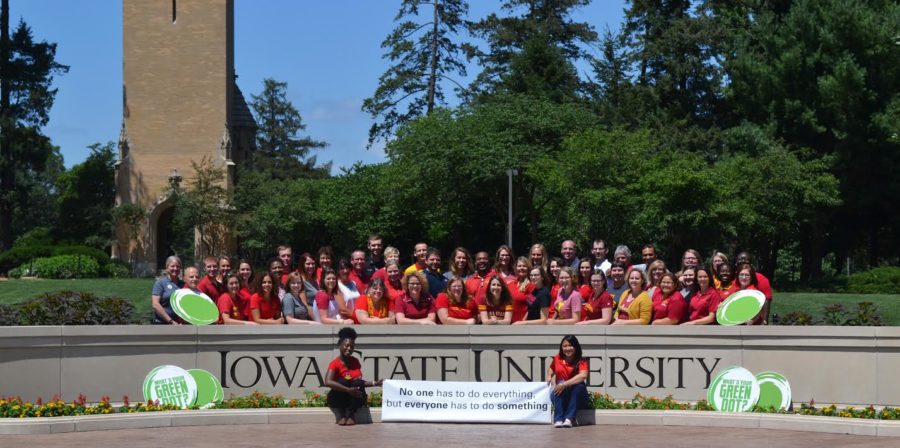Sexual assault prevention in practice with Green Dot, other initiatives
Faculty and staff who participated in the first round of facilitator training of the Green Dot program pose by the Iowa State University sign.
August 19, 2017
More than 50 percent of college sexual assaults occur in the months of August, September, October and November, according to rainn.org. Also, students are at an increased sexual violence risk during the first six weeks of first semester, commonly known as a ‘red zone’.
According to a 2015 campus climate survey, 15.4 percent of Iowa State students indicated that they had witnessed someone acting in a sexually violent or harassing manner. Among such bystanders, 52.4 percent indicated that they did nothing.
To combat power based violence on campus, Iowa State opened its Green Dot trainings to students on Jan. 20., after faculty and staff trainings and promotion around campus during fall term.
Iowa State made the decision to implement Green Dot last spring. According to the program’s official website, livethegreendot.com, the program likens red dots to both acts of power-based violence and inaction towards such violence, and likens green dots to words and behaviors that promote and prevent those acts on campus.
“The program is comprehensive, so it systematically is supposed to reduce incidents of violence on campus,” said Jazzmine Brooks, Student Wellness’s Violence Prevention Coordinator. “It should be everywhere – any visitors, student on campus, faculty and staff will know what this campus stands for.”
The first week of school has been a time for students and staff to bring awareness to both the Green Dot launch and the behaviors that it strives to encourage. Three days a week, the Peer Wellness Educators from the Student Wellness Center will be hosting ‘Be Well’ huts, talking to students about subjects like healthy relationships, consent and bystander intervention.
Additional outreach was also done by members of Student Government, who will be introduced to the program and wish to bring it to the students.
“A group of people know exactly what it is and know exactly how great it is, and then the majority of the student body doesn’t really know yet,” Natalie Pellegrino, Student Government’s Sexual Misconduct Prevention Director, said. “So I think it’s important to really give that outreach to the senator for them to know exactly what it is, exactly what it can do, and then to then give the message back their constituency councils, and then bring it to the faculty, bring it to the new students.”
Pellegrino also hopes to do more outreach on campus this semester, utilizing social media and making simple, accessible materials with a complete list of resources that students can use in the event of a sexual assault.
“During these first six weeks, if it does happen, we want those students to know, especially if they’re a freshman, sophomore, transfer student who are still familiarizing themselves with Iowa State to begin with and may not know what we have on campus to help them,” Pellegrino said. “We want to get all that out there as soon as possible.”
While the Green Dot program will formally launch on Sept. 27, and take around three years to fully integrate on a college campus, it won’t be around forever.
“For however long it takes, Green Dot won’t be in existence on campus because we have systematically done things to make sure students know about resources, about healthy relationships, boundaries… they will know from the time they step on campus for orientation to the time they leave,” Brooks said.
“It’s not meant to be something that lasts forever. It just helps campuses start to evolve around systems that need to be put in place to create more of an awareness and support around bystander intervention.”
Green Dot will continue to offer training sessions during the second and third week of February.

















